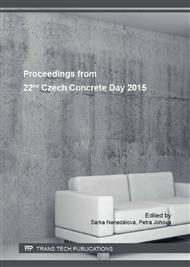p.267
p.273
p.278
p.284
p.290
p.296
p.301
p.309
p.315
Numerical Modeling of the Interaction of Subsoil and Reinforced Concrete Slab
Abstract:
The influence of the physically-nonlinear behavior of the structure and interaction between the upper structure and foundation are the aspects which influence the results of the subsoil-structure interaction analysis. The aim of the application of computational model is to determine the most apposite distribution of stress and deformation due the contact stress in the footing bottom. This contact stress is especially dependent to the load. It also depends on the subsoil stiffness, upper structure stiffness and foundation stiffness too. Numerical analyses of contact task were made with FEM. The test sample for the task was a reinforced concrete foundation slab model loaded during experimental loading test. The subsoil is heterogeneous. Its properties are different from the idealized behavior of the linear elastic isotropic homogeneous material. Application of inhomogeneous half-space allows better capture the subsoil behavior because of increasing modulus of deformability with increasing depth of subsoil model. Results of FEM analyses were also confronted with the values measured during the experiment.
Info:
Periodical:
Pages:
290-295
Citation:
Online since:
April 2016
Authors:
Price:
Сopyright:
© 2016 Trans Tech Publications Ltd. All Rights Reserved
Share:
Citation:


